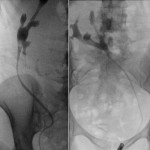Article of the Week: Central obesity is predictive of persistent storage LUTS after surgery for BPE
Every Week the Editor-in-Chief selects an Article of the Week from the current issue of BJUI. The abstract is reproduced below and you can click on the button to read the full article, which is freely available to all readers for at least 30 days from the time of this post.
In addition to the article itself, there is an accompanying editorial written by a prominent member of the urological community. This blog is intended to provoke comment and discussion and we invite you to use the comment tools at the bottom of each post to join the conversation.
Finally, the third post under the Article of the Week heading on the homepage will consist of additional material or media. This week we feature a video from Dr. Mauro Gacci discussing his paper.
If you only have time to read one article this week, it should be this one.
Central obesity is predictive of persistent storage LUTS after surgery for Benign Prostatic Enlargement: results of a multicenter prospective study
OBJECTIVE
To evaluate the impact of components of metabolic syndrome (MetS) on urinary outcomes after surgery for severe lower urinary tract symptoms (LUTS) due to benign prostatic enlargement (BPE), as central obesity can be associated with the development of BPE and with the worsening of LUTS.
PATIENTS AND METHODS
A multicentre prospective study was conducted including 378 consecutive men surgically treated for large BPE with simple open prostatectomy (OP) or transurethral resection of the prostate (TURP), between January 2012 and October 2013. LUTS were measured by the International Prostate Symptom Score (IPSS), immediately before surgery and at 6–12 months postoperatively. MetS was defined according the USA National Cholesterol Education Program-Adult Treatment Panel III.
RESULTS
The improvement of total and storage IPSS postoperatively was related to diastolic blood pressure and waist circumference (WC). A WC of >102 cm was associated with a higher risk of an incomplete recovery of both total IPSS (odds ratio [OR] 0.343, P = 0.001) and storage IPSS (OR 0.208, P < 0.001), as compared with a WC of <102 cm. The main limitations were: (i) population selected from a tertiary centre, (ii) Use exclusively of IPSS questionnaire, and (iii) No inclusion of further data.
CONCLUSIONS
Increased WC is associated with persistent postoperative urinary symptoms after surgical treatment of BPE. Obese men have a higher risk of persistent storage LUTS after TURP or OP.




This is an excellent article that has significant implications for management of LUTS.
Two years ago, I had some symptoms of LUTS. I was told about alpha-blockers, reducatase inhibitors and a TURPS, but I didn’t fancy long term drugs, nor an operation, and I asked what else I could do.
I then had the metabolic syndrome and its effects explained to me, something most patients will never have heard of. The explanation was a revelation.
I decided to try an experiment – I cut my BMI from 30.1 to 25.2, by losing 20 kg in weight over 6 months by slimming an exercise.
2 months into the programme, my LUTS symptoms had decreased by about 90%. By the end of the programme, the LUTS was entirely gone.
The conventional explanation of LUTS is that LUTS is due to prostate enlargement. However, if that were the right explanation, my weight loss should not have reduced/eliminated the LUTS, because weight loss as such will not reduce the prostate size.
So, I looked for a better explanation, and it was not hard to find in the scientific and medical literature.
There are many biological papers that explain that it is release of nitrous oxide as a muscle relaxant that enables the relevant bladder muscle to open. There are also many medical papers that explain that insulin resistance inhibits release of nitrous oxide. There are further numerous medical papers that demonstrate that obesity – particularly visceral fat – prohibits insulin resistance. I would be happy to cite papers, if asked to do so.
And so we have a chain, provable scientifically: obestity ⇒insulin resistance ⇒ inhibition of release of muscle relaxant. Hence, LUTS
A man who has too much visceral fat is liable to develop LUTS, because that fat promotes insulin resistance and this leads to insufficient muscle relaxant.
I propose that, if that man loses the fat, the cause of the insulin resistance is removed, and the LUTS can be diminished or eliminated.
When, however, one looks at most professional urological websites, one generally finds that the role of obesity as a cause of LUTS barely gets a mention. There is a lot to read about the drugs or a TURPS, but very little to read about there possibly being a natural cure to a natural problem. Maimonides held that nothing that can be cured by diet and exercise, should be treated by anything else. There is evidence that, in LUTS treatment, urologists today may be paying too little attention to his advice.
If I am right in my explanation for LUTS, then the drugs and the TURPS procedure are somewhat mis-targeted, and miss the real problem. The alpha-blockers seek artificially to ease muscle relaxation by changing nearby blood flow; the reducatase inhibitors seek to reduce prostate size. However, neither of these treatments actually deal with the real source of the problem in obese men – inhibition of the natural muscle relaxant the body itself produces. As for TURPS as being the solution – drilling a wider hole, an indiscriminate and unsubtle treatment, does not tackle the real source of the problem, which is a biochemical one.
It is not surprising, therefore, that the excellent paper on which I am commenting shows that, for many obese men, TURPS is no cure to their problem of LUTS. The reason is, I suggest, that TURPS does not tackle the true underlying cause of LUTS in many such men.
Difficult as it may be to persuade men to slim down radically, if reduction/elimination of LUTS can be held out as the carrot, I believe many men will choose that option in preference to drugs or TURPS. At the moment, however, I believe that the link between weight and LUTS is not always adequately explained to the presenting patient, but it should be.